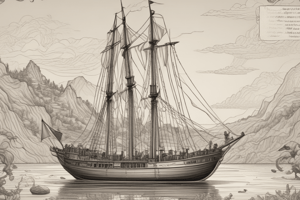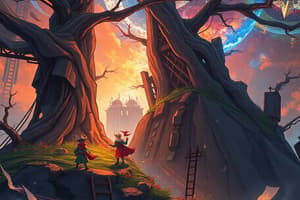Podcast
Questions and Answers
What role does the setting play in a story?
What role does the setting play in a story?
- It defines only the time period of the story.
- It influences character behavior and plot development. (correct)
- It has no impact on atmosphere or mood.
- It only provides the physical location.
Which of the following best defines a character in a story?
Which of the following best defines a character in a story?
- Only the main character who drives the plot.
- A static element that does not change throughout the story.
- Any person, animal, or personified object within the narrative. (correct)
- An essential part of the setting that provides context.
What is a key component of a plot?
What is a key component of a plot?
- Theme, which represents the moral of the story.
- Setting, which only describes the time and place.
- Character, which remains unchanged throughout the narrative.
- Clear structure consisting of introduction, rising action, climax, falling action, and resolution. (correct)
What does conflict contribute to a story?
What does conflict contribute to a story?
What characterizes the theme of a story?
What characterizes the theme of a story?
How does point-of-view influence a story?
How does point-of-view influence a story?
Which of the following best describes tone in a story?
Which of the following best describes tone in a story?
What is true about dynamic characters?
What is true about dynamic characters?
Which statement about conflict is correct?
Which statement about conflict is correct?
What does a well-developed theme typically do?
What does a well-developed theme typically do?
Flashcards are hidden until you start studying
Study Notes
Setting
- Represents the physical location, time period, and social/cultural context.
- Creates atmosphere and mood.
- Influences character behavior and plot.
Character
- A person, animal, or personified entity in the story.
- Can have a backstory that shapes their personality.
- Described by physical appearance, personality, background, and motivations.
- Can be dynamic (changing) or static (unchanging).
Plot
- Series of events in a story, often presented as an arc.
- Includes introduction, rising action, climax, falling action, and resolution.
- Provides structure and direction for the narrative.
Conflict
- A challenge or problem that drives the plot.
- Types of conflict: person vs. person, person vs. nature, person vs. society, and person vs. self.
- Creates tension and drama in the story.
Theme
- The central idea, belief, moral, lesson, or insight of the story.
- Answers the "Why?" of the story.
- Can be universal or specific to a culture or time period.
- Explored through the events of the story.
Point-of-View
- Determines who is telling the story.
- First person ("I"), Third person ("he/she/it"), Second person ("you").
- Limited, multiple, or omniscient perspectives.
- Impacts the reader's experience and relationship with the characters and events.
Tone
- The overall emotional feeling or meaning of the story.
- Conveyed through word choices, theme, imagery, symbolism, and sounds of words.
- Should be consistent throughout the story.
Style
- Refers to how things are said in a story.
- Includes word choices, sentence structure, dialogue, metaphors, similes, and hyperbole.
- Contributes to the tone and overall feel of the story.
- Can create unique and memorable prose.
Studying That Suits You
Use AI to generate personalized quizzes and flashcards to suit your learning preferences.




